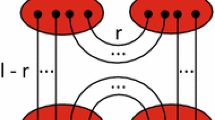Abstract
In this paper we obtain general integral formulas for probabilities in the asymmetric simple exclusion process (ASEP) on the integer lattice \({\mathbb{Z}}\) with nearest neighbor hopping rates p to the right and q = 1−p to the left. For the most part we consider an N-particle system but for certain of these formulas we can take the \(N\to\infty\) limit. First we obtain, for the N-particle system, a formula for the probability of a configuration at time t, given the initial configuration. For this we use Bethe Ansatz ideas to solve the master equation, extending a result of Schütz for the case N = 2. The main results of the paper, derived from this, are integral formulas for the probability, for given initial configuration, that the m th left-most particle is at x at time t. In one of these formulas we can take the \(N\to\infty\) limit, and it gives the probability for an infinite system where the initial configuration is bounded on one side. For the special case of the totally asymmetric simple exclusion process (TASEP) our formulas reduce to the known ones.
Similar content being viewed by others
References
Alcaraz, F.C., Droz, M., Henkel, M., Rittenberg, V.: Reaction-diffusion processes, critical dynamics, and quantum chains. Ann. Phys. 230, 250–302 (1994)
Andréief, C.: Note sur une relation les intégrales définies des produits des fonctions, Mém. de la Soc. Sci., Bordeaux 2, 1–14 (1883)
Baik, J., Deift, P.A., Johansson, K.: On the distribution of the length of the longest increasing subsequence in a random permutation. J. Am. Math. Soc. 12, 1119–1178 (1999)
Gwa, L.-H., Spohn, H.: Bethe solution for the dynamical-scaling exponent of the noisy Burgers equation. Phys. Rev. A 46, 844–854 (1992)
Hough, J.B., Krishnapur, M., Peres, Y., Virág, B.: Determinantal processes and independence. Probability Surveys 3, 206–229 (2006)
Johansson, K.: Shape fluctuations and random matrices. Commun. Math. Phys. 209, 437–476 (2000)
Lieb, E.H., Liniger, W.: Exact analysis of an interacting Bose gas. I. The general solution and the ground state. Phys. Rev. 130, 1605–1616 (1963)
Liggett, T.M.: Interacting Particle Systems. [Reprint of the 1985 original]. Springer-Verlag, Berlin (2005)
Liggett, T.M.: Stochastic Interacting Systems: Contact, Voter and Exclusion Processes. Springer-Verlag, Berlin (1999)
Liggett, T.M.: Private communication, April 17, 2007
Pólya, G., Szegö, G.: Aufgaben und Lehrsätze aus der Analysis. Springer-Verlag, Berlin (1964)
Prähofer, M., Spohn, H.: Current fluctuations for the totally asymmetric simple exclusion process. In and Out of Equilibrium, Progress in Probability 51, 185–204 (2000)
Rákos, A., Schütz, G.M.: Current distribution and random matrix ensembles for an integrable asymmetric fragmentation process. J. Stat. Phys. 118, 511–530 (2005)
Sasamoto, T.: Spatial correlations of the 1D KPZ surface on a flat substrate. J. Phys. A 38, L549–L556 (2005)
Schilling, A.: Private communication, Apr. 6 2007
Schütz, G.M.: Exact solution of the master equation for the asymmetric exclusion process. J. Stat. Phys 88, 427–445 (1997)
Soshnikov, A.: Determinantal random fields. Russ. Math. Surv. 55, 923–975 (2000)
Spohn, H.: Exact solutions for KPZ-type growth processes, random matrices, and equilibrium shapes of crystals. Physica A 369, 71–99 (2006)
Spitzer, F.: Interaction of Markov processes. Adv. Math. 5, 246–290 (1970)
Sutherland, B.: Beautiful Models: 70 Years of Exactly Solvable Quantum Many-Body Problems Singapore: World Scientific, 2004
Yang, C.N., Yang, C.P.: One-dimensional chain of anisotropic spin-spin interactions. I. Proof of Bethe’s hypothesis for the ground state in a finite system. Phys. Rev. 150, 321–327 (1966)
Yau, H.-T.: \((log t)^{2/3}\) law of the two dimensional asymmetric simple exclusion process. Ann. Math. 159, 377–405 (2004)
Zeilberger, D.: Private communication, Feb. 14 2007
Author information
Authors and Affiliations
Corresponding author
Additional information
Communicated by H. Spohn
An erratum to this article is available at http://dx.doi.org/10.1007/s00220-011-1249-2.
Rights and permissions
About this article
Cite this article
Tracy, C.A., Widom, H. Integral Formulas for the Asymmetric Simple Exclusion Process. Commun. Math. Phys. 279, 815–844 (2008). https://doi.org/10.1007/s00220-008-0443-3
Received:
Accepted:
Published:
Issue Date:
DOI: https://doi.org/10.1007/s00220-008-0443-3



